
Gouramis, or gouramies, are a group of freshwater anabantiform fish that comprise the family Osphronemidae. The fish are native to Asia—from the Indian Subcontinent to Southeast Asia and northeasterly towards Korea. The name "gourami", of Indonesian origin, is also used for fish of the families Helostomatidae and Anabantidae.

The tinfoil barb is a tropical Southeast Asian freshwater fish of the family Cyprinidae. This species was originally described as Barbus schwanenfeldii by Pieter Bleeker in 1853, and has also been placed in the genera Barbodes and Puntius. The specific epithet is frequently misspelled schwanefeldii.

Bang Bo is a district (amphoe) of Samut Prakan province in Thailand.
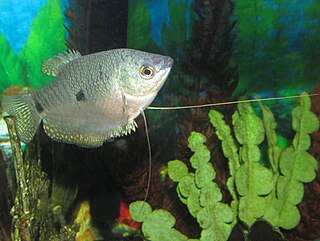
The three spot gourami, also known as the opaline gourami, blue gourami, and gold gourami, is a species of fish native to southeastern Asia, but also introduced elsewhere. This gourami gets its name from the two spots along each side of its body in line with the eye, considered the third spot. This species is of minor commercial importance as a food fish in its native range and is also farmed. It is also popular in the aquarium trade. The species reaches 15 cm in standard length.
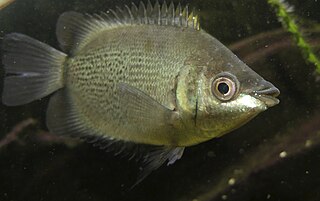
Kissing gouramis, also known as kissing fish or kissers, are medium-sized tropical freshwater fish comprising the monotypic labyrinth fish family Helostomatidae. These fish originate from Mainland Southeast Asia, Greater Sundas and nearby smaller islands, but have also been introduced outside their native range. They are regarded as a food fish and they are sometimes farmed. They are used fresh for steaming, baking, broiling, and pan frying. The kissing gourami is a popular aquarium fish.

The paradise fish, paradise-fish, paradisefish, or paradise gourami is a species of gourami found in most types of fresh water in East Asia, ranging from the Korean Peninsula to northern Vietnam. This species can reach a standard length of 6.7 cm, though most are only about 5.5 cm . Paradise gouramis were one of the first ornamental fish available to western aquarium keepers, having been imported 1869 to France by the French aquarium fish importer Pierre Carbonnier in Paris. The paradise fish is one of the more aggressive members of its family. It is more aggressive than the three spot gourami, yet less pugnacious in nature than the less commonly kept combtail.

The dwarf gourami is a species of gourami native to South Asia.
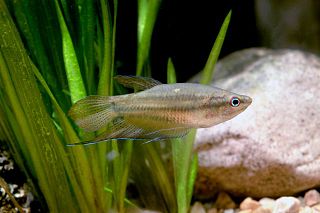
The croaking gourami is a species of small freshwater labyrinth fish of the gourami family. They are native to still waters in Southeast Asia and are distributed worldwide via the aquarium trade. Croaking gouramis are capable of producing a "croaking" noise using their pectoral fins.

The pygmy gourami, also known as the sparkling gourami, is a freshwater species of gourami native to Southeast Asia.
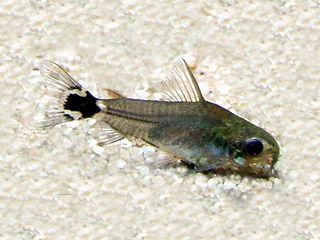
The dwarf corydoras, dwarf catfish, tail spot pygmy catfish, or micro catfish is a tropical freshwater fish belonging to the subfamily Corydoradinae of the family Callichthyidae. It originates in inland waters in South America, and is found in the Amazon River and Paraguay River basins in Argentina, Bolivia, and Brazil. The specific epithet hastatus means with a spear, in reference to the spearhead-like spot on the tail root.

The Anabantoidei are a suborder of anabantiform ray-finned freshwater fish distinguished by their possession of a lung-like labyrinth organ, which enables them to breathe air. The fish in the Anabantoidei suborder are known as anabantoids or labyrinth fish, or colloquially as gouramies. Some labyrinth fish are important food fish, and many others, such as the Siamese fighting fish and paradise fish, are popular as aquarium fish.

The thick-lipped gourami is a species of gourami native to Southeast Asia, and is a popular aquarium fish.

Osphronemus is a genus of large gouramis, the only genus within the subfamily Osphroneminae. These fish are known as the giant gouramis and are native to rivers, lakes, pools, swamps and floodplains in Southeast Asia, with O. exodon from the Mekong basin, O. laticlavius and O. septemfasciatus from Borneo, while O. goramy is relatively widespread. O. goramy has been introduced outside its native range in Asia, Africa and Australia.

The moonlight gourami, also known as the moonbeam gourami, is a labyrinth fish of the family Osphronemidae native to Indochina. This peaceful species is a popular aquarium fish.

Trichopodus is a genus of tropical freshwater labyrinth fish of the gourami family found in Southeast Asia. Gouramis of the genus Trichopodus are closely related to those of Trichogaster ; species of both genera have long, thread-like pelvic fins used to sense the environment. However, Trichopodus species have shorter dorsal fin base and, when sexually mature, are much larger, with the largest, the snakeskin gourami, capable of reaching a length of over 8 in (20 cm).

The honey gourami is a species of gourami native to India and Bangladesh.

The leopard bush fish, also known as leopard bushfish, spotted ctenopoma, leopard ctenopoma, spotted climbing perch, spotted leaf fish, spotted cichlid or spotted bushfish, is a freshwater fish. It is a member of the family Anabantidae, which is part of a group popularly known as labyrinth fish.

Trichogaster fasciata, the banded gourami or striped gourami or Colisa or Kholshe, is a tropical labyrinth perch found in some Asian countries like Bangladesh, Eastern India, Northeastern India, Nepal, Upper Myanmar, China and Pakistan.
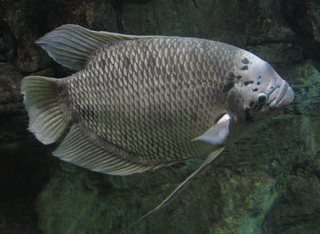
The giant gourami is a species of large gourami native to freshwater habitats in Southeast Asia. It has also been introduced elsewhere. The species is commercially important as a food fish and is also farmed. It can be found in the aquarium trade, as well. The species has been used for weed control on highly invasive aquatic plants like Salvinia molesta, as the giant gourami can be a voracious herbivore.

The Anabantiformes, collectively known as Labyrinth fish. are an order of air-breathing freshwater ray-finned fish with two suborders, five families and having at least 207 species. In addition, some authorities expand the order to include the suborder Nandoidei, which includes three families - the Nandidae, Badidae and Pristolepididae - that appear to be closely related to the Anabantiformes. The order, and these three related families, are part of a monophyletic clade which is a sister clade to the Ovalentaria, the other orders in the clade being Synbranchiformes, Carangiformes, Istiophoriformes and Pleuronectiformes. This clade is sometimes referred to as the Carangaria but is left unnamed and unranked in Fishes of the World. This group of fish are found in Asia and Africa, with some species introduced in United States of America.























